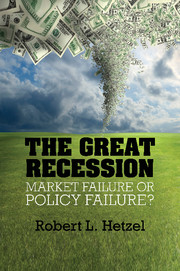Book contents
- Frontmatter
- Contents
- Figures
- Tables
- Preface
- One The 2008–2009 Recession
- Two Recessions
- Three The Great Contraction
- Four Monetary Policy and Bank Runs in the Great Depression
- Five Vigorous Recovery and Relapse
- Six Interwar International Monetary Experiments
- Seven Identifying the Shocks that Cause Recessions
- Eight From Stop-Go to the Great Moderation
- Nine Controlling Bank Risk Taking
- Ten The Housing Crash
- Eleven Bubble Trouble
- Twelve What Caused the Great Recession of 2008–2009?
- Thirteen What Caused the Great Leverage Collapse?
- Fourteen The Distinctions Between Credit, Monetary, and Liquidity Policy
- Fifteen Fed Market Interventions
- Sixteen Evaluating Policy
- Seventeen The Business Cycle
- Eighteen Why Is Learning So Hard?
- Nineteen How Should Society Regulate Capitalism?
- Postscript
- Bibliography
- Index
- References
Thirteen - What Caused the Great Leverage Collapse?
Published online by Cambridge University Press: 05 May 2012
- Frontmatter
- Contents
- Figures
- Tables
- Preface
- One The 2008–2009 Recession
- Two Recessions
- Three The Great Contraction
- Four Monetary Policy and Bank Runs in the Great Depression
- Five Vigorous Recovery and Relapse
- Six Interwar International Monetary Experiments
- Seven Identifying the Shocks that Cause Recessions
- Eight From Stop-Go to the Great Moderation
- Nine Controlling Bank Risk Taking
- Ten The Housing Crash
- Eleven Bubble Trouble
- Twelve What Caused the Great Recession of 2008–2009?
- Thirteen What Caused the Great Leverage Collapse?
- Fourteen The Distinctions Between Credit, Monetary, and Liquidity Policy
- Fifteen Fed Market Interventions
- Sixteen Evaluating Policy
- Seventeen The Business Cycle
- Eighteen Why Is Learning So Hard?
- Nineteen How Should Society Regulate Capitalism?
- Postscript
- Bibliography
- Index
- References
Summary
Two waves of deleveraging in financial markets occurred with one beginning in August 2007 and one in mid-September 2008. In each episode, in a discrete way, the unwillingness of cash investors to hold certain classes of short-term debt instruments increased. In the first episode, cash investors became unwilling to hold the asset-backed commercial paper (ABCP) used to finance the off-balance-sheet entities that commercial banks had set up to hold assets, especially mortgages. In the second episode, cash investors became unwilling to hold the shares of prime money-market funds that held the financial paper issued by banks and became unwilling to enter into the RP (repurchase) transactions that investment banks used to finance their inventories of securities.
The first wave of deleveraging caused banks to take onto their balance sheets mortgages with uncertain market value and, as a result, rendered problematic the solvency of one or more large banks. The second wave coincided with a shock that rendered uncertain the extent of the financial safety net protecting bank debt holders and, as a result, increased the uncertainty surrounding funding of banks. These funding problems and the uncertainty banks faced in predicting reserve outflows rendered them less able to provide a liquid market for debt instruments in general. There was then a general unwinding of funding through repurchase agreements as investors became uncertain of the liquidity of the pledged collateral. The most dramatic result was the sudden demise of the investment bank model that relied on very high leverage ratios achieved through RPs to finance inventories.
- Type
- Chapter
- Information
- The Great RecessionMarket Failure or Policy Failure?, pp. 239 - 256Publisher: Cambridge University PressPrint publication year: 2012

